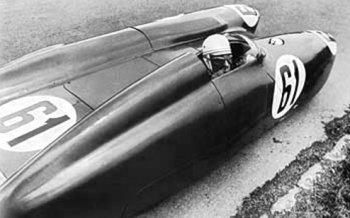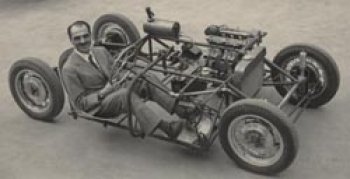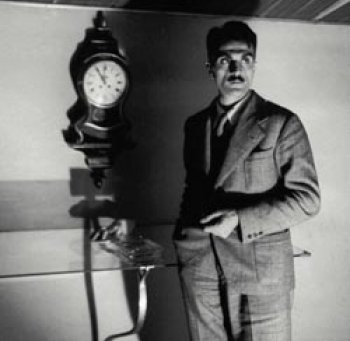|
GAM di Torino
and Castello di Rivoli are devoting a large exhibition to
one of the most outstanding figures of Italian culture,
Carlo Mollino.
Especially for this exhibition and in dedication of his
memory
Stola of the RGZ Group, an automotive industry leader in
the construction of show cars and styling prototypes, has
created a 1:1 scale model - almost 5 metres in length - from
his stillborn plans to build a car which would challenge for
the land speed record, a project which carefully studied
fresh aerodynamic advances and new innovative ideas.
Architect Carlo Mollino was born in 1905 and trained at the
Polytechnic in Turin, where he graduated in 1931. A skier,
driver, and aeroplane pilot, Mollino soon found himself well
inserted in the lively cultural environment in Turin,
between the two wars, where he made friends with
personalities in the world of culture and art. Together with
his meticulous technical training, which paid particular
attention to functional aspects, in his projects there was
always crosstalk between elements of modernity and a
considerable sensibility for the past.
From 1933 to 1973, the year when he suddenly died, he made a
total of only about ten architectural works. Particularly
noteworthy among his masterpieces was the Società Ippica
Torinese (1937 – 1940) in which rationalism intensifies and
extols metaphysical elements, the building for the Slittovia
di Lago Nero (1946-1947) in which the traditional Alpine
ski-lift building was rethought in original form, and the
new Teatro Regio in Turin (1965-1973), which interior
Mollino himself referred to as "a shape somewhere between an
egg and a half-open oyster".
Equally important was his work as an interior designer. His
Casa Miller (1936) and Casa Devalle (1939-1940) reveal a
surrealist taste. In 1949 he started teaching at the Faculty
of Architecture at the Polytechnic of Turin, and the
following year he was invited to take part in a travelling
exhibition in eleven American museums.
Mollino never worked for large industry. Most of his
furniture were carried out as one-off items. The most
prolific years of his career came to a sudden end in
December 1953, with the death of his father Eugenio. The
architect's activities were suspended in favour of his
passion for motoring and aerobatics. In 1954 he designed
Nube d'Argento, an exhibition for the national gas company,
and the following year he created, amongst others, a racing
car, the Bisiluro, which took part that year in the 24 Hours
at Le Mans. Later he created two cars which were aimed at a
challenge on the world land speed record, although these
dreams were to remain in a model state.
In 1960 Mollino returned to his work as an architect and
started redesigning the apartment in Via Napione in Turin,
which is now Museo Casa Mollino. Carlo Mollino left several
essays and books, ranging from narrative to architecture,
and on to skiing technique and photographic criticism,
including Il Messaggio dalla Camera Oscura, which was
written in 1943 and published in 1949.
|

 |
|
Carlo Mollino never worked for large industry. Most
of his furniture creations were carried out as
one-off items. The most prolific years of his career
came to a sudden end in December 1953, with the
death of his father Eugenio. Photo: Galerie Bischofberger. |
|

 |
|
In 1955 Carlo Mollino created amongst others a
racing car, known as the Bisiluro, which took part
that year in that year's 24 Hours at Le Mans.
Above: Mollino in the Bisiluro. Top: The Bisilero in
race action. Photo: E. Invernizzi. |
|
|

 |
|
Especially for this exhibition and in dedication of
his memory Stola of the RGZ Group, an automotive industry leader in
the construction of show cars and styling prototypes, has
created a 1:1 scale model from his stillborn plans
to build a car which would challenge for the land
speed record. |
|
 |
|
Architect Carlo Mollino was born in 1905 and trained
at the Polytechnic in Turin, where he graduated in
1931. A skier, driver, and aeroplane pilot, Mollino
soon found himself well inserted in the lively
cultural environment in Turin, between the two wars,
where he made friends with personalities in the
world of culture and art. |
|
|
Galleria Civica d’Arte Moderna e Contemporanea (GAM) di
Torino
The GAM exhibition will give an broad vision of Mollino's
rich life, revealing his spirit, his poetics, the subjects
and qualities of the artist's works through the display of
rare pieces of furniture. They are authentic, original and
unique, and include the table for Casa Orengo, a "vertebra"
table owned by the Brooklyn Museum of New York and granted
on loan for the first time since 1950, and a stunning desk
from the Centre Pompidou in Paris.
The exhibition will show works from private collections in
America and Europe, including the most complete of all,
which is that of gallery owner Bruno Bischofberger. The of
University of Miami - School of Architecture has produced,
during a special course, three models of specific buildings
and interiors that will be shown with a selection of famous
drawings by the architect, some of them made with both
hands. Some of the most interesting works on show at GAM
will be a record car 5,5 metres long built on a real scale
by Gruppo Stola of Cascine Vica, the Bisiluro car, from the
Museo della Scienza e della Tecnologia Leonardo da Vinci in
Milan, and the reconstruction of a bedroom of the thirties,
with walls lined with capitonné silk.
Castello di Rivoli Museo d’Arte Contemporanea
Meanwhile, on the third floor of the Castello di Rivoli
there is an exhibition that illustrates Mollino's great
passion for photography, which was an extremely important
aspect of his work. The display of his photographs includes
material never shown before from international collections
and from Museo Casa Mollino. A broad selection of works -
over two hundred in number - together with emblematic items
will make it possible to bring together various moments of
what was always an intimate part of Mollino's relationship
with his own creativity.
The photographic works of the Turin-born architect can be
divided into five main sections: photomontages of
architectural items and photographs of interiors for
specialised journals, black and white photography of a
surrealist nature from around the 1940s, ski photography -
which was mainly made for his volume on skiing techniques -
photography from the second half of the 1960s and, lastly,
his Polaroid shots of female portraits that he made from the
1960s up to the time of his death.
The exhibition is being curated by Museo Casa Mollino di Torino,
founded by Fulvio and Napoleone Ferrai, which has been
devoted since 1985 to promoting the figure of Carlo Mollino
in Italy and abroad. Fulvio Ferrari curated the first
exhibition of the architect's works in Italy in 1985, and in
1994 the first photographic retrospective of Mollino in the
United States. He’ s the author of several monographic
publications on the work of Mollino published in Europe, the
US and Japan.
|
|
|
|